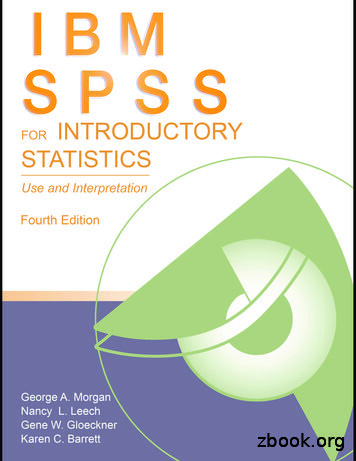ADVANCED PLACEMENT STATISTICS
or material is spiraled into homework problemsand test problems. When released free responses are assigned, some arefrom much earlier material so that the students are constantly exposed toearlier learned material.Course ProjectsThe course projects are in the form of extended writing assignments or oralpresentations. These are formal, therefore, form and technical adequacy areenforced. Some examples are given below. Students write up a summary of a magazine or newpaper article thatinvolves a statistical study. They are asked to identify the keycomponents of the study (who, what, where, why, how, etc.) and lookfor examples of misrepresentations or poor reasoning. More stock isput into their writing as they have just scratched the surface of thecourse material. Nielsen Data Project. Students input the Nielsen ratings from thecurrent week of television shows. They use Fathom to createappropriate charts, graphs, and summary statistics. They then write apaper comparing the viewership of the different television networks.Students then create a five minute presentation to an advertisingexecutive to tell what stations, shows, times, or days of week bring inthe most viewers.
Students are to design a taste test. They are expected to incorporateall stages of the design process from design (randomization,blindness, etc.) to data collection to a descriptive report of the results. Casino Lab. Students simulate different games (modified casinogames). They answer questions based on the results they got fromtheir simulation. Then they calculate the theoretical probabilitiesassociated with the specific game.As inference lends itself to lab work, the number and frequency of labsincrease as the year progresses. My expectations regarding work qualityalso increase. The students are required to connect their projects into thelarger scientific context.
Course Content and OutlineThe following outline describes this course’s content by book chapter andunit.Unit I – Exploring and Understanding DataChapter 1: Statistics Starts Here Activity: Read an article that references some statistics or statisticalstudy.Chapter 2: Data Types of data Create Data Lists in the TI84 Activity: In class survey analysisChapter 3: Displaying and Describing Categorical Data Frequency Tables Pie Charts Bar Charts Contingency TablesChapter 4: Displaying Quantitative Data Histograms Stemplots Dotplots Shape, Center, and Spread Timeplots Cumulative Frequency Graphs Re expressing Skewed Data Using the TI84 Activity: Weighing Pennies
Activity: Gabalot High Phone Calls (From YMS, The Practice ofStatistics) Video: Against All Odds – “Picturing Distributions” Chapter 5: Describing Distributions Numerically Describing Center: Mean and Median Describing Spread: Range, Interquartile Range, Standard Deviation Boxplots Outliers Using the TI84 Project: Nielsen Ratings (Described above)Chapter 6: The Standard Deviation as a Ruler and the Normal Model Standardized Scores The 68 95 99.7 Rule Percentiles and quartiles Normal Probability Plots Using TI84 Video: Against All Odds – “Normal Distributions”Unit I TestUnit II – Exploring Relationships Between VariablesChapter 7: Scatterplots, Association, and Correlation Making and Describing Scatterplots The Correlation Coefficient Properties of the Correlation Coefficient Straightening Scatterplots Using the TI84
Chapter 8: Linear Regression The Linear Model Residuals Least Squares Regression Line Regression to the Mean Coefficient of Determination Using the TI84 Activity: Da Vinci Activity for Linear RegressionChapter 9: Regression Wisdom Looking for Groups in Data Extrapolating Unusual and Influential Points Lurking Variables and Causation Activity: BVD Wandering Point Worksheet (from InstructorsResource Guide)Chapter 10: Re Expressing Data: Get It Stra
Chapter 8: Linear Regression The Linear Model Residuals Least Squares Regression Line Regression to the Mean Coefficient of Determination Using the TI84 Activity: Da Vinci Activity for Linear Regression Chapter 9: Regression Wisdom Looking for Groups in Data Extrapolating
Table of Contents Sequence strong List /strong . Unit 0 1 Introduction 2 How to take the placement tests 3 Placement Test I 4 Placement Test II 5 Placement Test III 6 Placement Test IV 7 Placement Test V 8 Placement Test VI 9 Placement Test VII 10 Placement Test VIII 11 Placement Test IX 12 Placement Test X
Table of Contents Sequence strong List /strong . 50-090816 Unit 0 1 Introduction 2 How to take the placement tests 3 Placement Test I 4 Placement Test II 5 Placement Test III 6 Placement Test IV 7 Placement Test V 8 Placement Test VI 9 Placement Test VII 10 Placement Test VIII 11 Placement Test IX
Advanced Placement (AP ) Statistics (APSTATS) B Syllabus . Course Name APSTATS B Advanced Placement (AP ) Statistics – Semester B . Course Information . APSTATS B is the second semester of this two-semester course. AP Statistics gives students hands-on experience in collecting, analyzing, graphing, and interpreting real-world data.
of numerical data (statistics with capital "S") 2: a collection of quantitative data (statistics with lowercase "s") The study of Statistics is unlike any Math class that you have taken before. Advanced Placement Statistics acquaints students with the major concepts and tools for collecting, analyzing, and drawing conclusions from data.
Statistics Student Version can do all of the statistics in this book. IBM SPSS Statistics GradPack includes the SPSS Base modules as well as advanced statistics, which enable you to do all the statistics in this book plus those in our IBM SPSS for Intermediate Statistics book (Leech et al., in press) and many others. Goals of This Book
LOS ANGELES PIERCE COLLEGE APMS MATH PLACEMENT CRITERIA ( 114 - 315 ) Placement Rule Placement Courses Placement Placement Level Unblocked Name Message MDTP ALGEBRA READINESS TEST 26 ARS 5 MATH 115 Math 115 You may enroll in Math 115, ASAP or Math 228A.
Placement Memorandum/PM means this placement memorandum issued by the Issuer in respect of the Debentures proposed to be issued. Private Placement Offer cum Application Letter(s)/PPOA/Debt Disclosure Document means the private placement offer cum application letter(s) prepared in compliance with Section 42 of the Companies Act, 2013 read with the
Job Placement and Job Placement Fee Guidelines V2.4 TRIM ID: D16/1329258 ARC ID: D16/7772420 Effective Date: 01 October 2016 Job Placement and Job Placement Fee Guidelines V 2.4 Disclaimer This document is not a stand-alone document and does not contain the entirety of Disability Employment Services Programme Providers' obligations.























